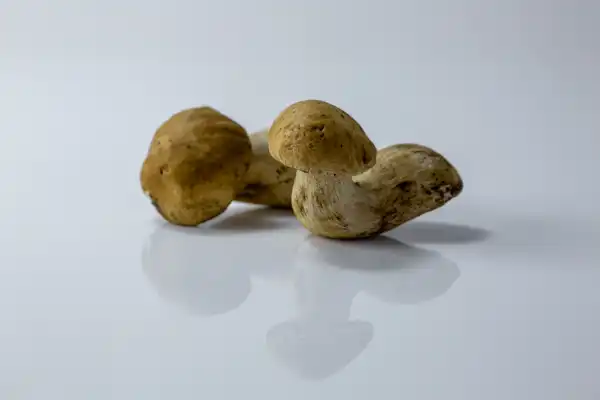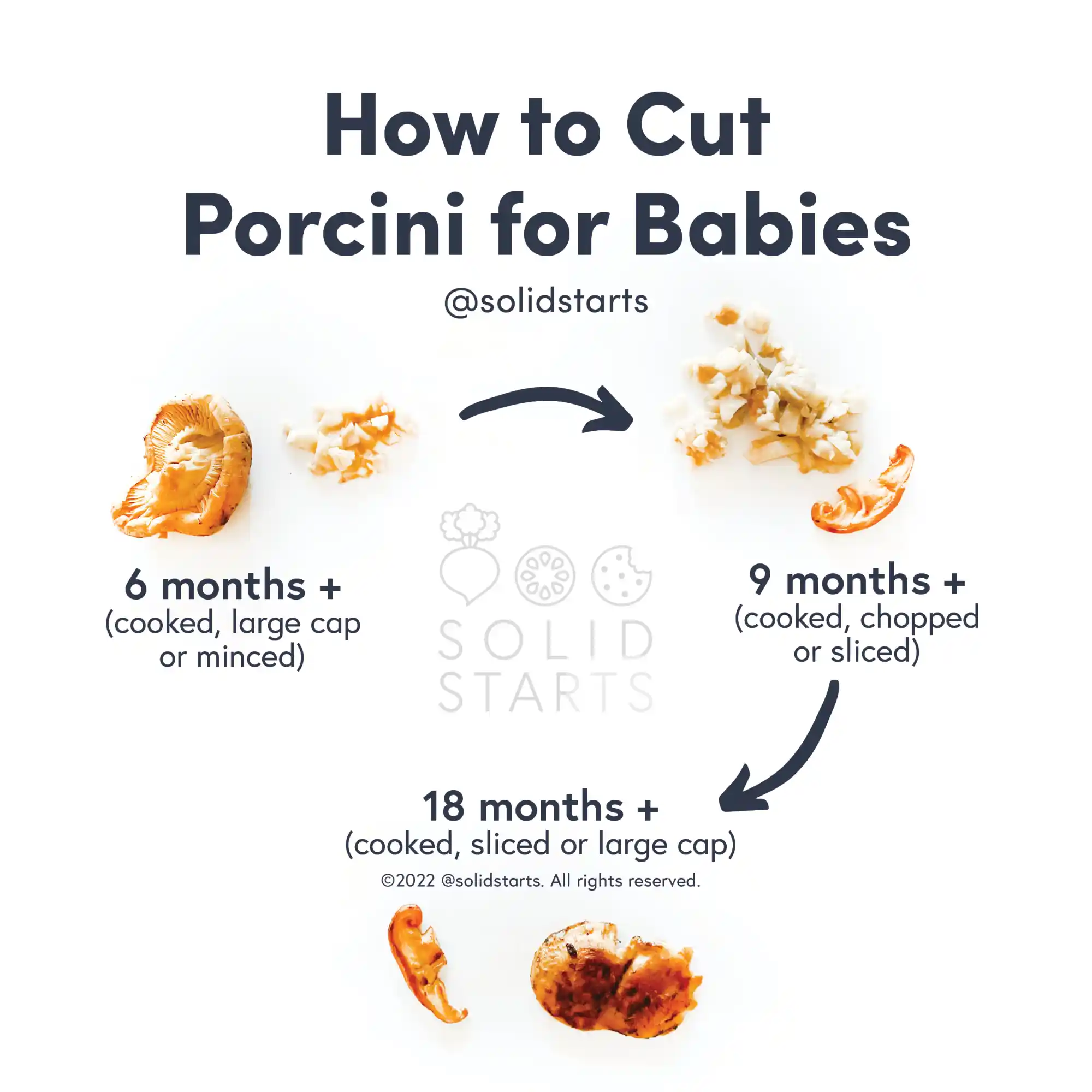Porcini Mushroom
Fungi
Age Suggestion
6 months
Iron-Rich
Yes
Common Allergen
No

When can babies eat porcini mushrooms?
Porcini mushrooms may be introduced as soon as baby is ready to start solids, which is generally around 6 months of age. Avoid foraging mushrooms to share with baby unless you are an expert mycologist as there are plenty of poisonous look-a-like species in the wild.
Where do porcini mushrooms come from?
Porcini mushrooms grow in the wild all over the northern hemisphere. They are widely known as cep and penny buns in English, but in Italian, the name “porcini” means “piglet” – a nod to the wild boars who like to feast on this forest food. Unlike oyster mushrooms and other popular species, porcini mushrooms are difficult (though not impossible) to cultivate on mushroom farms. Limited commercial production keeps prices high for fresh porcini in many parts of the world, though dried porcini mushrooms are increasingly available.
Videos
Are porcini mushrooms healthy for babies?
Yes. Porcini mushrooms are a great source of fiber, iron, and potassium, and they offer a bit of calcium. Fiber aids baby’s developing gut microbiome, iron supports healthy red blood cells, potassium strengthens heart health, and calcium helps baby build strong bones. Porcini mushrooms also contain the compound ergothioneine, an antioxidant that can help support the body’s resilience.
Make sure to buy porcini mushrooms from a reputable source and avoid foraging your own mushrooms unless you are an expert mycologist, as there are many poisonous species growing in the wild.
Are porcini mushrooms a common choking hazard for babies?
Yes, especially the cylindrical stems. Porcini mushrooms can be chewy, slippery and challenging for new eaters to break down in their mouths. To reduce the risk, finely chop the mushrooms and cook fully. Dried mushrooms should be fully rehydrated in boiling water and chopped before serving. As always, make sure to create a safe eating environment and stay within an arm’s reach of a baby during mealtime. For more information, visit our section on gagging and choking and familiarize yourself with common choking hazards.
Are porcini mushrooms a common allergen?
No. Mushroom allergy is rare, although not unheard of. There have been reports of anaphylaxis, as well as rashes amongst those handling mushrooms. Mushrooms also contain chitin, a common carbohydrate found in crustaceans and insects that may contribute to an allergic response in certain individuals.
Individuals with Oral Allergy Syndrome (also called pollen food allergy syndrome), particularly those sensitive to mold, may also be sensitive to mushrooms. Oral Allergy Syndrome typically results in short-lived itching in the mouth and is unlikely to result in a dangerous reaction. Cooking mushrooms can help minimize and even eliminate the reaction.
Dried porcini mushrooms may be preserved with sulfites. While sulfites are not a common allergen, certain individuals, particularly those with asthma, can have allergy-like reactions to added sulfites. If sulfites are a concern, avoid ingredients such as sulfur dioxide, potassium bisulfate, potassium metabisulfite, sodium bisulfite, sodium metabisulfite, and sodium sulfite to name a few.
As you would when introducing any new food, start by offering a small quantity for the first few servings. If there is no adverse reaction, gradually increase the amount over future meals.
Can babies have raw porcini mushrooms?
Yes, although cooked porcini mushrooms are easier for baby to digest and less challenging to chew. Cooking these mushrooms also helps lower the risk of foodborne illness.
Can porcini mushrooms help babies poop?
Yes. Porcini mushrooms are rich in fiber and fluid to support the gut microbiome, bulk up poop, and hydrate the intestines. Mushrooms also offer prebiotics – special carbohydrates that help friendly gut bacteria flourish. Introduce high-fiber foods like mushrooms gradually and regularly in baby’s diet as tolerated; a little gassiness or a few blowouts is just a sign that baby’s digestive system is adjusting, so no need to remove the food from the diet. Remember that pooping patterns can vary significantly from baby to baby. If you have concerns about baby’s pooping and digestive function, talk to your pediatric healthcare provider.
How do you introduce porcini mushrooms to babies with baby-led weaning?
Every baby develops on their own timeline, and the suggestions on how to cut or prepare particular foods are generalizations for a broad audience.
6 to 8 months old:
Mix finely chopped, cooked porcini mushrooms into foods that are easy for baby to pick up and munch on, such as egg strips, or mix into soft, scoopable foods like mashed vegetables, porridges, or yogurt. If you have very large fresh porcini, remove the stem, cook the cap, and offer the whole cap as finger food and let baby munch on it. Make sure the porcini cap is bigger than baby’s mouth, and if they munch it down to a smaller size, simply take it away and offer another piece of food in its place. Dried porcini may be used to flavor stocks and broths or ground into a powder to season baby’s food.
9 to 17 months old:
Offer bite-sized pieces of cooked porcini on their own or fold chopped, cooked porcini mushrooms into grains, porridges, and other soft, scoopable foods. Continue to use dried porcini to flavor foods meats, pastas, stews, and other dishes to share with the child.
18 to 24 months old:
Offer cooked, chopped porcini mushroom on its own or as part of a meal. At this age, if the child has mature chewing and tearing skills, you can try moving back up in size to large pieces of cooked porcini mushroom. Try modeling how to use your back teeth to thoroughly chew the mushroom with big, exaggerated mouth movements.
Expand baby’s palate with recipes from around the world with our 100 Dinners for Babies & Toddlers guide.
Written by
Expert Tips Delivered to Your Inbox
Sign up for weekly tips, recipes and more!
The content offered on SolidStarts.com is for informational purposes only. Solidstarts is not engaged in rendering professional advice, whether medical or otherwise, to individual users or their children or families. No content on this site, regardless of date, should ever be used as a substitute for direct medical advice from your doctor or your medical or health professional, nutritionist, or expert in pediatric feeding and eating. By accessing the content on SolidStarts.com, you acknowledge and agree that you are accepting the responsibility for your child’s health and well-being. In return for providing you with an array of content “baby-led weaning” information, you waive any claims that you or your child may have as a result of utilizing the content on SolidStarts.com.









